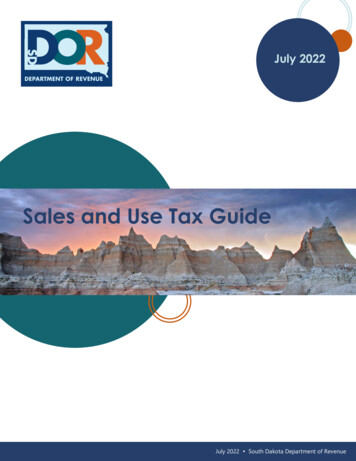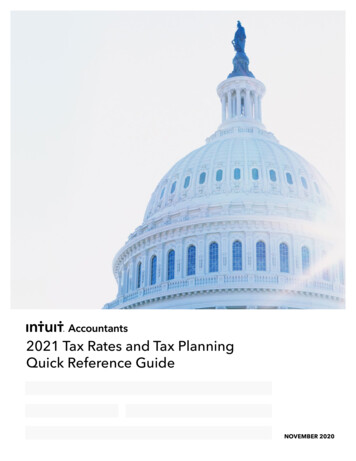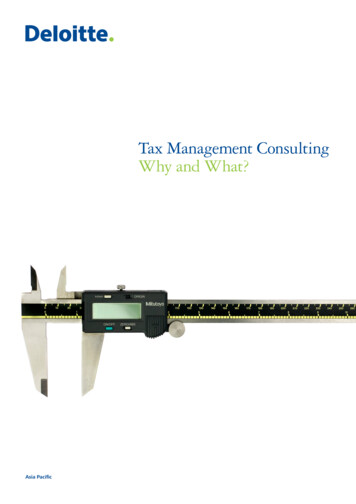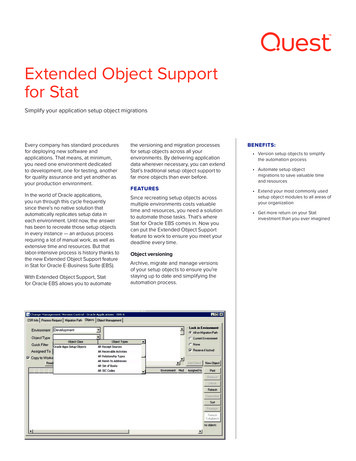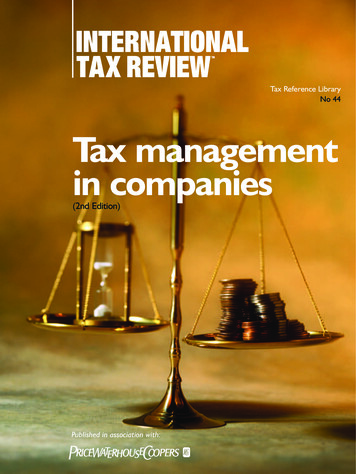
Transcription
Tax Reference LibraryNo 44Tax managementin companies(2nd Edition)Published in association with:
Tax management in companiesContents3Introduction - Coping with changeThe world of corporate taxes is changing and there is no going back, says John ClymerApplying corporate responsibility to taxThe practice of corporate responsibility is subject to much debate. Tax has a role not to be neglected in these discussions,say Urs Landolf and Susan SymonsThe great crossoverRüdiger Loitz, Tobias Taetzner and Tom Weber explain how finance can help improve tax effectivenessGaining controlTax risk management, tax accounting and being “in control” have been on the agenda of most tax departments in therecent past, say Eelco van der Enden and Robert van der Laan6141823The role of technologyTechnology is often misunderstood and under-utilised by most tax functions. However, its advantages are plainly apparent,says Mark SchutzmanRole of the head of taxFabio Dell’Anna and Andreas Staubli outline issues to consider in a rapidly changing world2833Stakeholder communicationOver the last few years there has been a great deal of change in the global tax environment, calling for effective communicationbetween the tax function and stakeholders in tax, says Tim CoxStructuring the tax functionTony Elgood sets out some of the structural options and comments upon their pros and consProcess or technology?Thierry Morgant outlines some tax accounting and reporting issueswww.internationaltaxreview.com37411
Tax management in companiesTEditorialNestor House, Playhouse Yard, London EC4V 5EX UKTel: 44 20 7779 8789Fax: 44 20 7779 8500EDITORIALManaging editor: Ralph CunninghamEmail: rcunningham@euromoneyplc.comAmericas editor: Catherine SnowdonSub-editor: Miles LangEmail: csnowdon@euromoneyplc.comEmail: mlang@euromoneyplc.comEMEA editor: Joanna FaithReporter: Jack GrocotEmail: jfaith@euromoneyplc.comEmail: jgrocott@euromoneyplc.comReporter: David StevensonPRODUCTIONEmail: dstevenson@euromoneyplc.comProduction editor: Mary OsinibiEmail: mosinibi@euromoneyplc.comADVERTISINGPublisher: Oliver WatkinsProject manager: Andrew TappinEmail: owatkins@euromoneyplc.comEmail: atappin@euromoneyplc.comBusiness manager: Ethne TwomeyGroup publisher: Danny WilliamsEmail: etwomey@euromoneyplc.comDirector: Christopher FordhamSUBSCRIPTIONS AND CUSTOMER SERVICESCustomer services: 44 20 7779 8610UK subscription hotline: 44 20 7779 8999US subscription hotline: 1 800 437 9997International Tax Review is published 10 times a year by Euromoney InstitutionalInvestor PLC, London. Euromoney Institutional Investor PLC, 2008. The copyright of all editorial matter appearing in this review is reserved by the publisher.No matter contained herein may be reproduced, duplicated or copied by any meanswithout the prior consent of the holder of the copyright, requests for which shouldbe addressed to the publisher. Although Euromoney Institutional Investor PLC hasmade every effort to ensure the accuracy of this publication, neither it nor any contributor can accept any legal responsibility whatsoever for consequences that mayarise from errors or omissions, or any opinions or advice given. This publication isnot a substitute for professional advice on specific transactions.Directors: PM Fallon, chairman and editor-in-chief, The Viscount Rothermere,joint president, Sir Patrick Sergeant, joint president, PR Ensor, managing director,D Alfano, JC Botts, SM Brady, CR Brown, MJ Carroll, DC Cohen, CHC Fordham,J Gonzalez, CR Jones, RT Lamont, G Mueller, NF Osborn, CJFS Sinclair,ax management was aterm that was little usedby companies until a fewyears ago. The tax director made his management aware ofnasty surprises in his department or,preferably, dealt with anythingbefore they developed that way.Other than that, what has nowdeveloped into a new practice areaof its own, sometimes known as taxRalph Cunninghamrisk management, was just anotherManaging editor,part of a tax director’s role, withoutany more significance than, for International Tax Reviewexample, compliance or structuring.Regulation has changed all that.Tax authorities are more and more aggressive around theworld and having been doing their best to make sure thatbusiness managers can have no excuses for ignorance abouttheir tax function. And other regulators, for exampleaccounting standards organisations, with rules such as theSarbanes-Oxley Act and FIN 48, have ensured that therelationship between tax has taken on an importance forthe rest of the business that it may not have had.It is in this context that International Tax Review co-publishes the second edition of its Tax Management inCompanies guide with PricewaterhouseCoopers. The guide isthe 44th in the Tax Reference Library series, which has alsocovered other topics such as transfer pricing, indirect taxesand outsourcing. They are designed to give in-house tax counsel the most cutting-edge advice for planning their corporation’s tax strategy and structuring transactions in these fields.More are on the way.As the following articles from PricewaterhouseCoopersshow, there is a lot more to tax management in companiesthan making sure that the right amount of tax is paid on timein the places where it should be paid. Stakeholder communication, the role of technology and the structure of the taxfunction are other topics that contribute to effective tax management in companies.We hope the insights these specialist tax advisers offer provide you with some valuable knowledge when dealing withthe issues.J Wilkinson, JP Williams.International Tax Review (USPS No: 005-126) is published monthly exceptJanuary and August for 745 per year by Euromoney Institutional Investor PLC,c/o SmartMail, 140 58th Street, Suite 2b, Brooklyn, NY 11220-2521. PeriodicalsPostage paid at Brooklyn, NY and additional mailing offices. Postmaster: Sendaddress changes to International Tax Review c/o SmartMail, 140 58th Street, Suite2b, Brooklyn, NY 11220-2521.This publication is not included in the CLA license.Copying without permission of the publisher is prohibited ISSN 0958-75942www.internationaltaxreview.com
Tax management in companiesCoping with changeThe world of corporatetaxes is changing andthere is no going back,says John ClymerTax executives have three options when it comes to changes: fight them,ignore them or embrace them. Most tax executives will spend some timefighting and ignoring before realising that in order to survive they mustembrace change. Those companies that are not US registrants may nothave experienced the full force of this wave of change yet, but macro trends have away of spreading throughout the globe. Understanding the drivers of change may notbe as interesting as what leading tax departments are planning to do about them.Another Enron?It’s a story that has been heard many times. The rash of accounting scandals between2001 and 2002 led to enormous bankruptcies, a crisis in the capital markets and ultimately intense regulations. In a few isolated cases, even tax employees were caughtin the storm in ways that would have been difficult to imagine previously. However,rather than relive Enron and Sarbanes-Oxley, it can be concluded that these changesrepresent the early chapters of a story that continues today. But if Enron is the firstchapter, then, in order to adequately appreciate what is really going on, there must bea prologue.The good old daysTo fully understand the whole story, it is necessary to go way back in time – beforeEnron. Although it was only seven years ago, it seems like ancient history today. Atthe time, the majority of tax departments were primarily focused on adding value totheir companies. For some, this culminated in tax planning that was much too aggressive – although it may not have seemed so at the time. However, for most it meantthat their energy was focused on managing cash taxes and earnings rather than operations. This lack of focus on operational issues is the true beginning of the story.While many companies chose to invest in financial systems, the needs of the taxfunction within these companies were often overlooked and rarely considered. Thisleft significant deficiencies in data access and quality. At the time, this was seen as nomore than a major inconvenience. Investments in tax technology were limited andhome-grown Excel spreadsheets were almost always the exclusive tools for tax provisions. Regardless, the concept of internal controls did not seem to apply to a taxdepartment.At about the same time that Enron was facing its fate, global tax authorities werefocusing on attacking aggressive tax planning schemes. What was once widely regarded as acceptable practice became an embarrassment, a major liability or, in the mostextreme cases, a criminal issue. This led to increased discussions about the role of taxin managing risk and enhancing community relationships – certainly not common discussion topics at tax conferences before that time.www.internationaltaxreview.com3
Tax management in companiesIn the old days, accounting for taxes was viewed differently as well. For example, if a tax department failed to performthe work necessary to compute and claim a tax credit, theresulting tax expense may have been a bit high but it was notnecessarily a problem. If a study was pursued in a later yearand significant refunds were obtained on amended returns,the benefit simply increased earnings in the year the refundwas received and the tax executive emerged a hero. Apply thesame to today’s environment and the outcome is different.Instead of a hero, the tax executive may be singled out as theculprit who caused an embarrassing restatement to priorfinancial statements.Tax balance sheet accounts were viewed differently in thosedays as well. One could easily argue that the primary focus wason the income statement. In fact, as long as the current incomewas stated properly, there was often quite a high threshold ofmateriality before a balance sheet adjustment was deemed necessary. Although not discussed in recent accounting literature,it is quite clear that Enron, Worldcom and other accountingscandals triggered an intense focus on the balance sheet. Thisshift of attention resulted in countless surprises when the taxbalance sheet accounts were suddenly examined like they neverhad been before. Tax executives quickly learned that deferredtax accounts must now be supported by precise data ratherthan simply the cumulative sum of prior book/tax differences.Accounting for uncertain tax positions was more of an artthan a science back then as accounting literature and businesspractices left room for many different approaches to recording tax cushion. It is this renewed focus on the balance sheetthat ultimately led to the painful adoption of FIN 48 for companies that were subject to US GAAP.In summary, in the environment before Enron, senior taxexecutives had generally placed a greater priority on value andless on accounting, controls and efficiency. In other words,the vast majority of tax departments were totally unpreparedfor the pressures that they would soon face.Embracing changeAfter all the changes brought forth over the last several years,many tax functions find themselves struggling to meet all ofthe demands imposed on their departments. A few examplesof today’s challenges include: primary focus on tax accounting rather than tax planning; resource shortages – especially tax accounting expertise; high overtime/low morale; poor internal controls; delayed closing processes; less collaboration within tax and with other business units; poor data quality and access; outdated technology; and inefficient processes.Many tax executives continue to believe that if they rideout the storm everything will eventually improve. Others are4beginning to realise that this tough situation may actuallypresent a unique opportunity for their department to fix itsproblems. So what are these forward-thinking tax executivesdoing to embrace change? They are taking advantage oftoday’s burning platform to push for a widened and strategicview of what must be done to truly fix their problems. Thiswidened strategic outlook is best illustrated by the approachthat many are taking when re-engineering their tax provisionprocesses.Tax accountingOver the past few years, we have seen a huge increase in newtax technology vendors and applications – the most popularbeing the new tax provision tools that have hit the market.These applications are designed to replace the array of taxprovision spreadsheets that exist in typical tax departments.In most companies, tax provision spreadsheets began modestly, with functionality added on as the years progressed.Eventually these spreadsheets became so complicated thatonly their designers really understood the winding flow of calculations. A strange but effective analogy is to compare working with today’s typical tax provision spreadsheet to your lastvisit to an old hospital. Within the hospital there may havebeen an original wing that was fairly simple to navigate: however, the original blueprint of the wing did not contemplatenor allow for easy expansion. Subsequently, over the years,new wings were added and countless improvements weremade until no human being would be able to navigate theirway through without endless signs to guide their way.Ultimately, only the people who work there every day knowwhere they are going.Tax provision spreadsheets are often loved by those whowork with them on a daily basis. With plenty of time to perform the calculations, they generally work well. Their breakdown often occurs with unexpected last-minute accountingchanges. With pressure to rerun the provision quickly, shortcuts are often taken which result in broken links or othercomputational errors. Because the spreadsheets are hard tofollow, analytics cannot quickly detect the errors until muchlater in the process. This is a common cause of control deficiencies.With all the shortcomings in tax provision spreadsheets,there remains an increasing demand for improvements infunctionality, as well as reliability and controls. Thesedemands have led to today’s tax provision technology explosion. In fact, in the US, if a public company has not alreadyimplemented tax provision technology, the odds are very highthat it is on their short-term agenda.Unfortunately, many early adopters of the various technologies were disappointed when they failed to achieve thebenefits that they originally promised. However, it was notthat the tools were at fault. It was the fact that the scope ofthe implementation was confined entirely within the fourwww.internationaltaxreview.com
Tax management in companiescorners of the tax department, leaving the biggest data accessand process challenges untouched. The same old painfulprocesses were still necessary to gather the data needed tofeed the new technology and an entirely new set of spreadsheets were necessary to replace the old tax provision spreadsheets that were retired. The end result was far from automated or efficient.Today sees a trend towards taking a much more holisticview of tax operations rather than taking shortcuts that resultin failure. Many leading companies are reaching the conclusion that their biggest obstacles to achieving operationalimprovements are data quality and access issues, and additionally the use of post-closing top-side journal entries. Byaddressing the configuration of enterprise resource planning(ERP) and consolidation software, as well as the chart ofaccounts and accounting practices, the data necessary to drivetax calculations can be extracted directly from financial systems to tax accounting technology without any manual intervention. In many companies, as much as 80% of the book ortax differences can be automated as well, which eliminatesthe need for most of the new spreadsheets that would haveotherwise been necessary. In addition to improving accuracy,tax systems can be configured so that this same informationwill flow directly from the tax provision technology to taxcompliance technology applications, resulting in greatlyincreased efficiencies.The benefits of taking a holistic view of process and technology improvements go well beyond increased efficiency andaccuracy. Because much of the time that is saved relates tothe middle of the closing process, the preparation of the taxprovision is streamlined, leaving plenty of time for analyticsand little overtime. In addition, late changes may be rerunquickly without the added worries of broken spreadsheetlinks or human error.Taking a holistic approach to the implementation of taxprovision technology is only one example of a great opportunity to embrace change. The articles in this publication werewritten by many talented tax professionals from around theworld, and they cover a myriad of topics which focus on people, process, technology, data, controls, strategy, structure andcommunications – all of the key enablers that drive today’stax function. Like the tax provision technology exampleabove, the authors are able to illustrate how forward-thinkingsenior tax executives can address their challenges head-on bytaking a very close look at every aspect of their tax departments. By embracing these challenges, senior tax executivescan become the champions of positive change and avoidbecoming the victims of disaster.BiographyJohn ClymerPricewaterhouseCoopers USA125 High StreetBoston, Massachusetts 02110United States of AmericaTel: 1 617 530 64 33Fax: 1 813 207 34 97Email: john.clymer@us.pwc.comJohn has been a US partner at PwC since 1993, is based in Boston,Massachusetts and serves as the global leader of PricewaterhouseCoopers’Tax Management and Accounting Service (TMAS) practice. TMAS focuseson all aspects of tax operations, from helping our clients improve everyaspect of their internal operations to outsourcing critical core functions. Bytaking a holistic view of today's operational challenges, TMAS combines thepower of PwC's Tax Function Effectiveness, Tax Accounting Services andGlobal Compliance Services networks to truly meet our clients' needs.www.internationaltaxreview.com5
Tax management in companiesApplying corporateresponsibility to taxThe practice of corporateresponsibility is subject tomuch debate. Tax has arole not to be neglectedin these discussions, sayUrs Landolf andSusan SymonsAuniversal definition of corporate responsibility (CR) has yet to be discovered. However, it is widely accepted that it is about doing businessresponsibly, acting with integrity towards all stakeholders involved directly with the business (including customers, employees, suppliers and business partners). Corporate responsibility involves acknowledging and responding to theneeds and concerns of others whose interests are affected by its operations (localcommunities, governments, society and the environment, for instance).Corporate responsibility is about how a business takes into account the impact thatits operations have on the economic, social and environmental fabric of society witha view to maximising the benefits and minimising the downsides that it perceives.These three elements are often referred to as the “triple bottom line” (JohnElkington, Towards the Sustainable Corporation: Win-Win Business Strategies forSustainable Development, 1994). Corporate responsibility or sustainability reportingis a process for publicly disclosing an organisation’s economic, environmental andsocial management and performance.Many companies find that financial reporting alone no longer satisfies the needs ofthe various stakeholders that have an interest in it. These stakeholders will includeshareholders, customers, investors, government and the community at large.Organisations disclose how they manage risks through CR reporting, such as how theyhandle hazardous waste, minimise negative impacts such as the emissions of greenhouse gases and embed values and principles. An example for the latter is requiringsuppliers to meet certain standards of employment and create value through goodhuman capital management.How does corporate responsibility apply to tax?Many organisations have given a great deal of thought to their CR in relation to socialand environmental issues. The economic dimension has arguably been the least developed and it is often equated to financial performance. However, although related, thefinancial and economic elements are not equivalent. The financial element focuses onthe market value of transactions and how they pass through the accounts, while theeconomic element takes a wider perspective, extending beyond the boundaries of theorganisation.Paying tax is considered to be an important part of a company’s economic impactand contribution to society, as taxes fund social investment. But a call for a CR agenda on tax is not simply a call for companies to pay more tax. It is about applying therelevant principles of CR. These include: accountability; transparency and disclosure; engagement with stakeholders;6www.internationaltaxreview.com
Tax management in companies an ethical approach; a commitment to add economic value; and setting an appropriate tax strategy.Alignment of tax strategy to general businessprinciplesIs tax more than a legal concept?Companies may choose to deal with their tax issues withinthe letter of the law to reduce their tax burden. The judgment of Lord Tomlin (in IRC v Duke of Westminster) underpins this: “Every man is entitled if he can to order his affairsso that the tax attaching under the appropriate Acts is lessthan it would be otherwise.”However, some stakeholders take the view that reducing acompany’s tax burden by simply applying the letter of the lawis not enough in terms of their CR to the society in which thecompany operates. Some believe that companies should alsoobserve and apply the spirit of the law when dealing withtheir tax issues. They should view tax not merely as a cost tothe business but as a contribution to society and its infrastructure – in essence, a fee paid to society for the right to operatewithin it.This implies that tax is not simply a legal concept but thatthere are ethical values that can and should be consideredwhen considering and setting a company’s tax strategy. Valuessuch as integrity, fairness, respect and openness are all relevant when setting a tax strategy and taking commercial decisions.Corporate responsibility concepts increasingly have relevancein the day-to-day running of a business, and many businessesconsider CR principles in setting their overall business strategy. To date this has certainly been the case in the area of supply chain management with the emergence of fair-trade principles, even if this has perhaps been for the basic commercialpolicy objective of minimising damage to reputation or toenhance a brand.Increasingly, such concepts are being applied to tax, particularly as a growing number of stakeholders are taking an interest in tax. The diagram below gives a good indication of theinterested parties and the sorts of issues that they wish toaddress. In many jurisdictions, tax is being pushed up the corporate responsibility agenda by government and is playing amore significant role in the economic element of their triplebottom line.The practical approach to tax and CR is therefore to aligna company’s tax strategy with the wide-reaching businessstrategy.Tax planning and CRHistorically, the determination of what can be defined asacceptable tax planning has referred back to the concepts oftax evasion and tax avoidance.Diagram 1: Stakeholders and what they are interested inInvestors Clarity on tax risk position Year on year stability of tax charge Understanding likelihood fordeferred tax to materialiseConsumers Reduced sales taxesBoard Management of tax riskincluding reputation risk Ethical business practicesTax Tax compliance Building trusted relationshipwith HMRCGovernments Maximising corporate tax take Attracting and retaininginvestment Financing public servicesFinance Reduced tax costs Achievement of financial targetsExternal affairs/CR Avoiding negative press onanti-avoidance Alignment of business principleswith tax practicesNGOs Campaigning against taxavoidance Asking companies to pay a faircontribution in all countries ofoperation Combating ‘capital flight’www.internationaltaxreview.com7
Tax management in companiesDiagram 2: Categorisation of tax planningAbsoluteboundarybetweenillegal andlegalEvasion always illegalSham legal withthe appearanceof legalityAvoidancetechnically legalBlurredboundarybetweenacceptable andunacceptableMitigation legaland welcomedIn arriving at a responsible tax strategy, the board ofthe company will need to have considered and have aperspective on how the business views the fair or proper amount of taxes that tax authorities and other stakeholders expect. The starting point may be to thinkabout where the organisation sits or should sit on thescale in diagram 3, where the higher the score the lessyou are concerned with CR in relation to tax.Information to help with disclosures around CRIn order for the board to properly address the CRissues that relate to tax and the tax strategy for theirorganisation, it will need to have access to information on allthe taxes that the company bears and collects. It will alsoneed to have some insight as to how this compares with otherorganisations of similar size or those that operate in the houseCoopers (PwC) developed the Total TaxContribution (TTC) framework.Tax evasion and tax avoidance are widely recognised andused terms. While both are concerned with the reduction ofa tax liability, evasion is illegal whereas avoidance is legal.Evasion typically involves suppression, concealment or misreporting; avoidance involves using the provisions in the taxcode. The difference between the two terms was encapsulated by former UK Chancellor of the Exchequer Denis Healeyas being “the thickness of a prison wall”.Therefore, the distinction between the two is not the The PwC TTC frameworkextent to which planning is undertaken but of the kind of The TTC framework enables tax information to be gatheredunder a consistent methodology to facilitate an improvedactivity that is engaged in.Lord Clyde said in the case of Ayrshire Motor Services and understanding of the tax position of the company and ultiRitchie v CIR in 1929 that “No man in this country is under mately to help with the reporting and communication of taxthe least obligation, moral or otherwise, so as to arrange his data. This provides a good foundation from which companieslegal relations to his business or to his property as to enable can respond to the increasing expectation of transparencythe Inland Revenue to put the largest possible shovel into his around tax matters. Not only does the framework take intoaccount corporate income tax, it also takes into account all ofstore.”Under this and similar doctrines tax planning is permissi- the business taxes borne or collected by a company, in orderble. Indeed it can be said that tax planning is legitimate in to determine a company’s total tax contribution to publicmost countries because the law offers the potential for eco- finances.The PwC TTC framework has two fundamental points ofnomic transactions to be structured in a number of differentways. Ultimately, business has an obligation to pay the principle. The first is to define what a tax is. It is importantamount of tax that is due under the law of the country in to be clear as to what kind of payments actually constitute atax. Some payments, such as corporate income tax, employeewhich it operates, and in accordance with the law.However, with the increasing interest in tax from other tax (PAYE) and VAT are obvious. The categorisation of somestakeholders, rightly or wrongly the public perception of what other payments is perhaps less clear-cut.As a starting point, a tax can be defined as something thatis considered acceptable tax planning has been changing. Aphrase much used in recent years in this respect is that com- is:panies should pay “a fair amount of tax”. So although in the- paid to the government;ory the distinction between what is acceptable and what is compulsory;not is absolute, it would also appear that there are clear lines used by the authority as part of the public finances; andas to what is legal and what is not, and the distinctionDiagram 3: Tax corporate responsibility scalebetween tax avoidance and tax evasion. In reality theboundaries have become blurred. This – the blurring ofthe boundaries – can in part be attributed to interestAppropriate level of taxMinimum taxTax planninged stakeholders considering tax issues from a CR perwhich “should be paid”legally requiredis unethicalspective. The diagram above shows one way ofexpressing the spectrum of categorisations that exist.Corporate responsibilityThis was developed by Lord Templeman, a noted andnow retired law lord in the UK, in a Privy Council case010(CIR v Challenge Corporation Ltd).8www.internationaltaxreview.com
Tax management in companies with no direct return of value toDiagram 4: Percentage of taxes borne by participants in the 2007the payer.survey of The Hundred Group in the UKThese basic principles are in line withthe OECD definition of a tax.Petroleum revenue taxThe second is to draw a funda5.7%mental distinction between businessBusiness ratesIrrecoverable VATtaxes borne by a company (the com11.5%7.8%pany’s own tax contribution, whichEmployers NICconstitutes a cost to the company)15.2%Stamp dutiesand taxes collected by the company1.5%(where the cost of the collection, andnot the tax itself, is a cost to theOthercompany). It is important to recog3.9%nise and include the taxes collectedOther taxesby a company as these demonstrate1.6%the role that the corporate sectorCorporation tax55.9%performs as unpaid tax collectors forEnvironmentalgovernmen
Tax risk management, tax accounting and being "in control" have been on the agenda of most tax departments in the recent past, say Eelco van der Enden and Robert van der Laan The role of technology 23 Technology is often misunderstood and under-utilised by most tax functions. However, its advantages are plainly apparent, says Mark Schutzman


